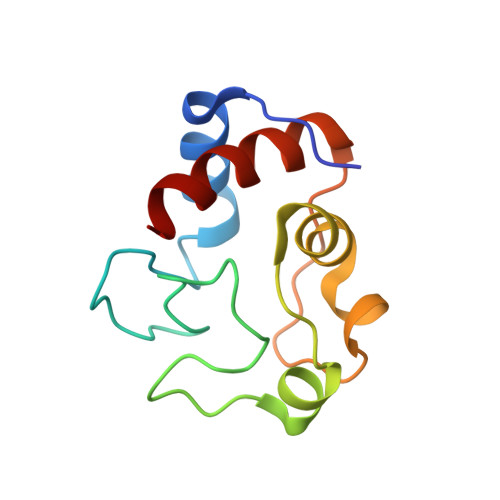Structure of a mitochondrial cytochrome c conformer competent for peroxidase activity.
McClelland, L.J., Mou, T.C., Jeakins-Cooley, M.E., Sprang, S.R., Bowler, B.E.(2014) Proc Natl Acad Sci U S A 111: 6648-6653
- PubMed: 24760830
- DOI: https://doi.org/10.1073/pnas.1323828111
- Primary Citation of Related Structures:
4MU8 - PubMed Abstract:
At the onset of apoptosis, the peroxidation of cardiolipin at the inner mitochondrial membrane by cytochrome c requires an open coordination site on the heme. We report a 1.45-Å resolution structure of yeast iso-1-cytochrome c with the Met80 heme ligand swung out of the heme crevice and replaced by a water molecule. This conformational change requires modest adjustments to the main chain of the heme crevice loop and is facilitated by a trimethyllysine 72-to-alanine mutation. This mutation also enhances the peroxidase activity of iso-1-cytochrome c. The structure shows a buried water channel capable of facilitating peroxide access to the active site and of moving protons produced during peroxidase activity to the protein surface. Alternate positions of the side chain of Arg38 appear to mediate opening and closing of the buried water channel. In addition, two buried water molecules can adopt alternate positions that change the network of hydrogen bonds in the buried water channel. Taken together, these observations suggest that low and high proton conductivity states may mediate peroxidase function. Comparison of yeast and mammalian cytochrome c sequences, in the context of the steric factors that permit opening of the heme crevice, suggests that higher organisms have evolved to inhibit peroxidase activity, providing a more stringent barrier to the onset of apoptosis.
Organizational Affiliation:
Department of Chemistry and Biochemistry, Center for Biomolecular Structure and Dynamics, and Division of Biological Sciences, University of Montana, Missoula, MT 59812.


















